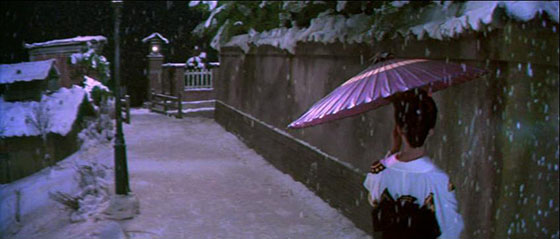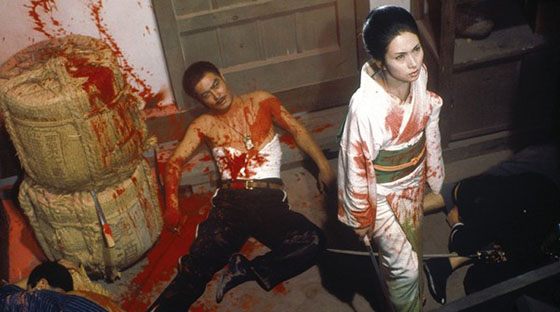
You better watch out. Better not cry, sucker. Because this month we’re taking a look at seven examples of cinematic revenge — the bloodier, the better.
Part 1: Lady Snowblood
In 2003, Kill Bill Vol. 1 introduced nascent movie geeks like me to the aesthetics of 70’s Japanese action films, blowing the dust off a whole swath of great flicks like Lady Snowblood. Released thirty years before Kill Bill, Snowblood served as one of Tarantino’s primary stylistic and narrative touchstones for his spaghetti-samurai-fu pastiche. The story, told in non-linear episodic fashion, tells the story of Yuki Kashima (a stunningly beautiful Meiko Kaji). Born in a Tokyo prison and raised to avenge the death and torture of her parents, Yuki is trained by Dokai (a hard-nosed master) in the art of slicin’ fools up. And slice she does, creating geysers of Argento red across the Japanese countryside.
This is a story about violence as inheritance; about the grudges that travel down bloodlines over generations. Yuki’s mission is all she knows, but it isn’t her mission, really. It’s her mother Sayo’s. After murdering one of the men who raped her and killed her husband, Sayo is thrown in a Tokyo prison. She starts having sex with every man she can, trying to conceive a boy to avenge her. But she doesn’t get a boy. Instead, she dies giving birth to Yuki in the film’s tense snowy opening.

Flash forward to Yuki’s adulthood. She’s a gorgeous badass who carries a sword in the handle of her umbrella, her humanity beaten from her through years of tough training. We’re introduced to Yuki in one of the film’s most memorable sequences, a bloody swordfight on brightly lit snowy night; the edges of the set quickly falling into deep shadow. It’s astonishing in its beauty and ferocity, and incredibly well directed by Toshiyo Fujita, who also directed the acclaimed sequel. The two Snowblood films are supposedly uncharacteristic of his style, but they are really the only two films in his extensive filmography that really broke out. He directed a handful of softcore “pink films”, some exploitation flicks, a bunch of well-received dramas and a few TV movies. Unfortunately, the vast majority of his filmography never made it out of Japan, and may likely be lost to time. It’s a shame, because in watching Lady Snowblood, you’ll see Fujita had one hell of an eye for this stuff.
The visual language of Japanese cinema in the mid-twentieth century was, to my eyes, way ahead of its time. Japanese films have always looked and felt different from Western cinema, but the hyperkinetic, over-the-top feel seen in much of Japan’s contemporary cinema (perhaps due to the influence of anime) is totally absent here. The film revels in its long takes and gritty handheld shots, really taking its time to create a distinct narrative and visual rhythm. Playing over these superb visuals is a classic soundtrack, which includes The Flower of Carnage (another element borrowed by Tarantino), immaculately sung by star Meiko Kaji herself.

If there’s one thing that troubles me about Lady Snowblood, it’s that Yuki is an amazing character — a skilled warrior with no time for anyone’s shit — but her mission and her mindset mean that Yuki lacks desires and motivations of her own. Dokai raises her to believe she is an asura, a demigod. “Even the Buddha has forsaken you,” he tells her. She lives to see a sequel, but does she have a reason to live? A potential romance with a journalist is briefly teased, but the two stay respectfully distant as they work on locating the last two scumbags on Yuki’s kill list. They’re great scumbags, too. The casting of the film’s four main villains is a huge strength, and they all remain memorable (as do their gruesome death scenes).
All of these things add up to this: Lady Snowblood is a bona fide masterpiece of its subgenre. Hell, it might be the best live action film ever adapted from a manga. And if you’ve never seen it, there’s no time like the present — The Criterion Collection’s new HD restoration is begging for a spot on your shelf.
Travis’ Rating: 




Out of a Possible 5 Stars